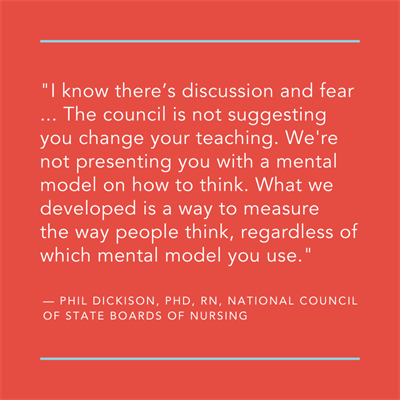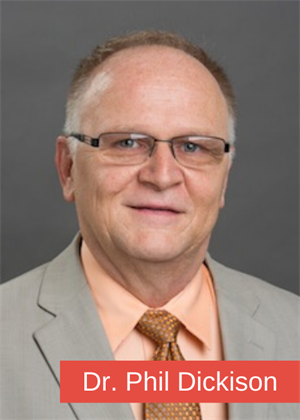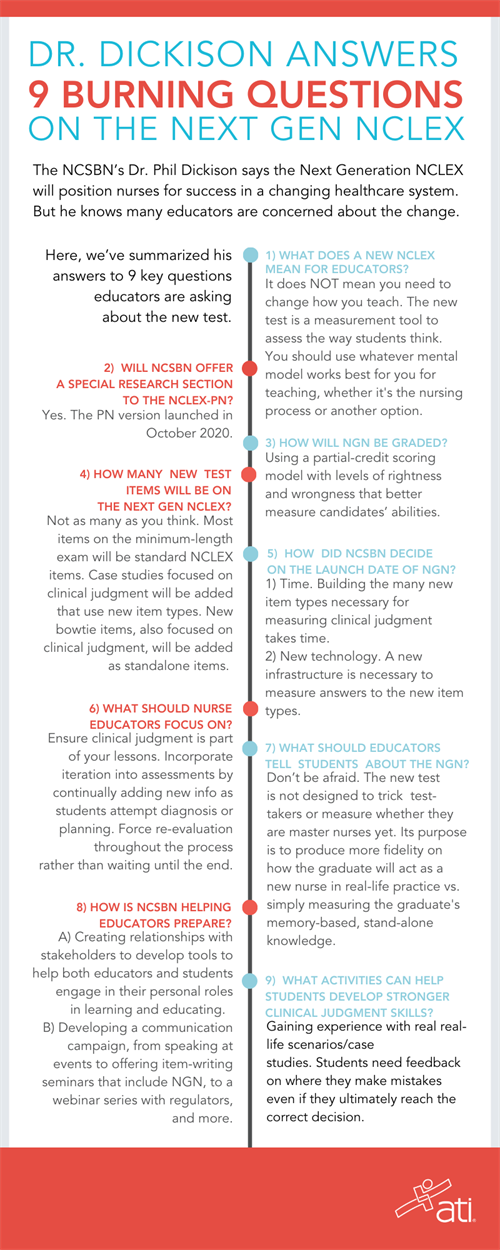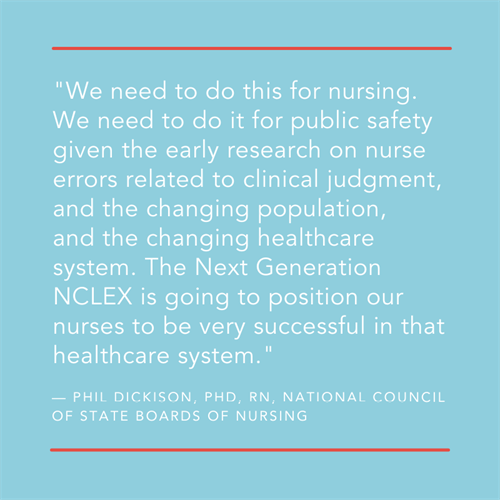NCSBN WANTS YOU TO BE PREPARED FOR THE NEXT GEN NCLEX
UNDERSTANDING WHY A NEW TEST IS NEEDED IS ONLY THE FIRST STEP
 If you’ve been part of a nursing conference over the last few years, you’ve likely seen a presentation by Phil Dickison, PhD, RN. As the Chief Officer, Operations & Examinations, at the National Council of State Boards of Nursing (NCSBN), his knowledge about the Next Generation NCLEX (NGN) has been in high demand. Nursing programs nationwide want to know how the new version of the test will impact their programs.
If you’ve been part of a nursing conference over the last few years, you’ve likely seen a presentation by Phil Dickison, PhD, RN. As the Chief Officer, Operations & Examinations, at the National Council of State Boards of Nursing (NCSBN), his knowledge about the Next Generation NCLEX (NGN) has been in high demand. Nursing programs nationwide want to know how the new version of the test will impact their programs. Sheryl Sommer, PhD, RN, CNE, ATI’s Chief Nursing Officer, has discussed the test with Dr. Dickison multiple times. The conversation that follows (edited for length and clarity) provides insight on why NCSBN began the process of launching the new exam and what's to come.
Question: What does a new NCLEX mean for educators and students?
Dr. Dickison: I know there’s discussion and fear: “Do we have to change everything we’re teaching?” No. The council is not suggesting you change your teaching. We’re not presenting you with a mental model on how to think. What we developed is a way to measure the way people think, regardless of which mental model you use. Why is that important? Because there are a variety of mental models. For example, the Benner model, the Tanner model, the information-processing model. All are ways that cognitive science has described how we think. What educators can expect from NGN is a way to evaluate their students using the Next Generation NCLEX model — regardless of which model is used in education.
Why is that important? Because there are a variety of mental models. For example, the Benner model, the Tanner model, the information-processing model. All are ways that cognitive science has described how we think. What educators can expect from NGN is a way to evaluate their students using the Next Generation NCLEX model — regardless of which model is used in education.From July 2017 through December 2018, NCSBN had more than 304,000 individuals interact with new item types designed to measure clinical judgment. None of them knew the NGN model; they’re being educated using a variety of models. What did our research see? A high correlation of people doing really well on the NCLEX did really well on the new items — without knowing the NGN model. Those people who did poorly on the NCLEX? They did poorly on the new items. What the NGN model allows us to do is look at those people near the cut — as we’re trying to determine, "Are you safe or not to be a nurse?" We’re now getting better measurement, more information. And that allows us to make better decisions relative to public safety.
Q: How was it determined that the Next Gen NCLEX will not occur until 2023?
Dr. Dickison: We have 2 big issues:
- We must build a lot of new item types so we can continue to use a CAT exam.
- The current algorithms that select items for students work.
However, the technology to deliver vignettes or case studies versus individual items must be built. So, we’ve got a technology and an item bank to build. NCSBN determined that we would not be successful building those — without cutting corners — until 2022. So, we moved the launch date to 2023 to ensure every process goes through the rigors that the NCLEX has become known for over the last 25 years.
Q: When will NCSBN offer a Special Research Section to PNs taking the NCLEX?
Dr. Dickison: After we finished the 2018 PN practice analysis, it confirmed that elements of clinical judgment within the PN scope of practice were also critical to public safety. That led us to begin developing PN items. Test-takers began answering those questions in October 2020.

Q: How many test items will be on the Next Gen NCLEX and how will it be graded?
Dr. Dickison: It depends on the length of the student’s exam. But there will probably be between 2 and 5 vignettes or scenarios. A vignette measures all 6 components of the clinical judgment measurement model. So if there were 2 vignettes with 6 items each, that’s 12. Or if there would be 5 vignettes with 6 items each, there would be 30. So somewhere between 12 and 30 items. I know that’s not a good answer, but I don’t have a good answer just yet, because we don’t know how many vignettes we need to actually stabilize the measurement on any individual at this point. We are researching that now. We believe it’s somewhere between 2 and 5 vignettes.
Q: Vignettes are NGN items with multiple questions within it that address all components of the model?
Dr. Dickison: Correct.
Q: What about item scoring?
Dr. Dickison: The Next Generation NCLEX will still be a computer adaptive test. And, it will continue to have many of the same item types that exist today, because you still must measure all those things. So, it’s important for everybody to understand that the Next Generation NCLEX is an entire test of these item types.
Second, it will be graded on a polytomous scoring model, which is akin to partial-credit scoring with levels of rightness and wrongness that depict different abilities of candidates.
Q: With the NCLEX coming in a couple of years, what should nurse educators focus on to prepare students?
Dr. Dickison: They need to focus on teaching students with whatever mental clinical judgment model they already use in their program in a way that they’re confident that their graduates can make clinical judgments. What do I mean by that? Look at the nursing process model. Generally, it’s viewed as linear. What we see students doing in our research is following that linear model, but then it becomes cyclical. They start out with assessment, and they walk all the way through the nursing process, and then they evaluate their client. Then, if the evaluation isn’t what was expected, they go back to the beginning and go through the process again. So it’s linear and cyclical.
What educators need to start impressing upon students is that the nursing process — and how you implement clinical judgment within the nursing process — should be iterative.
So, if I perform an assessment and get more information as I am attempting to either diagnose or plan, I should add that information and re-evaluate my diagnosis and plan instead of waiting for the end of the process to learn, "Did my original idea pan out?"
But, again, educators don’t have to change how they’re teaching. The content is the same. Instead, they should implement whatever mental model they’re using — whether it’s reflective, intuitive, human processing — it doesn’t matter which model they’re using. What matters is they’re using an iterative approach within the nursing process.
Q: What message should educators deliver to students, who probably don’t know a lot about the NGN yet.
 Dr. Dickison: Don’t create fear. My hope is that we’ll have sample items that students can interact with, so they don’t have a fear of the unknown. That’s No. 1.
Dr. Dickison: Don’t create fear. My hope is that we’ll have sample items that students can interact with, so they don’t have a fear of the unknown. That’s No. 1.
No. 2, the Next Generation NCLEX will produce, in some regards, more fidelity on answering questions about how students will practice in the context of nursing versus simply stand-alone knowledge students try to memorize that is assessed with multiple-choice answers.
So, be positive. Don’t create fear that, somehow, we’re trying to trick them or we’re trying to measure whether they’re a master nurse of 20 years. The new NGN items entail the same content that educators have been teaching for the last 3 or 4 years in their programs. It really is no different than the NCLEX today in that regard.
Q: What upcoming goals is NCSBN working toward to help educators prepare for Next Gen?
Dr. Dickison: One is creating a relationship with other stakeholders, such as ATI and the other large publishers — starting partnerships in which we can work together to create tools that will help both educators and students engage in their own personal roles in learning and educating. That’s never been done with the NCSBN before, so it’s a new endeavor. Also, creating a communication campaign. We’ll continue to do that and develop other knowledgeable people to do that. We’re going to begin putting on item-writing seminars, and we’re adding NGN into that those. We’re going to create a webinar series with regulators. So we’re planning a variety of things to interact with people who will eventually interact either directly or indirectly with this exam.
Q: What activities would be helpful for students so they develop the clinical judgment skills they need?
Dr. Dickison: I think students need more real real-life scenarios — real case studies. Those can be either a discourse or an activity in which students interact with real-life contextual situations and receive feedback. Because one of the problems I see with most products today is students pass or fail if they get to the end and made the right decision.
That’s the problem with the nursing process. You get all the way to the end, and you’re either good or bad. But you could have lucked on the right decision.
If I could give students feedback throughout that process, however, I could tell them where they made a mistake even though they got to the right decision. That’s what products available to educators and students have got to be able to do.
Let’s say some students complete clinical rotations. They bring back case studies and, let’s assume, they are not violating HIPPA. What a great teaching tool that becomes relative to clinical judgment. Because I can present the case slowly and have a discourse with the class: “Here was the presentation. Well, Jen, what did you see? Scott, what did you see? What are relevant cues to you?” There aren’t 2 people who are probably going to give you the same relevant cues. Next, ask students, “What are you going to do with these cues? How do they tell the story? Analyze these cues for me, and tell me what story they tell you.”
 And then you ask the students how their decisions would be different if there were changes in the scenario. “This happened to be Hospital X that has a Level 1 trauma center.” Or it’s the leading cardiac hospital, or the patient just came from an urgent care clinic. Those are contextual cues that may help a student change the prioritization of care. Then, throw in, “By the way, a significant other was with the patient. There are 2 children.” Etc. You let them build through the nursing process and force them to iterate.
And then you ask the students how their decisions would be different if there were changes in the scenario. “This happened to be Hospital X that has a Level 1 trauma center.” Or it’s the leading cardiac hospital, or the patient just came from an urgent care clinic. Those are contextual cues that may help a student change the prioritization of care. Then, throw in, “By the way, a significant other was with the patient. There are 2 children.” Etc. You let them build through the nursing process and force them to iterate.
I know there’s angst out there. There’s going to be angst with any change, and I don’t want the angst to cause people to become so negative that we’re not able to successfully measure clinical judgment ability. We need to do this for nursing. We need to do it for public safety given the early research on nurse errors related to clinical judgment, and the changing population, and the changing healthcare system.
The Next Generation NCLEX is going to position our nurses to be very successful in that healthcare system. So, I hope we can erase any negativity and work together with all the stakeholders to make nursing of the future what we all want it to be, which is focused on our clients and their public protection in the United States and worldwide.
